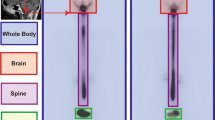Summary
The authors describe the techniques of isotope cisternography and ventriculography with high specific activity I131 and Tc99m albumin in children and adult patients. They have studied 35 patients including different type of obstructive and communicating hydrocephalus, microcephalic patients and patients with no intracranial pathology. The value, the limitations, and the potential damage of the test are discussed and the proper use of the two different tracers is assessed.
Similar content being viewed by others
References
Ashburn, W. L., andG. Di Chiro, Radioisotope cisternography and ventriculography. In: Radionuclide Applications in Neurology and Neurosurgery, Eds.Wang andPaoletti, pp. 163–190. Springfield, Ill.: Ch. C Thomas. 1970.
—,J. C. Harbert, W. H. Briner, andG. Di Chiro, Cerebrospinal fluid rhinorrhea studies with the gamma scintillation camera. J. Nucl. Med.9 (1968), 523–529.
Bannister, R., E. Gilford, andR. Kocen, Isotope encephalography in the diagnosis of dementia due to communicating hydrocephalus. Lancet2 (1967), 1014–1017.
Brocklehurst, G., Use of radio-iodinated serum albumin in the study of cerebrospinal fluid flow. J. Neurol. Neurosurg. Psychiat.31 (1968a), 162–168.
—, Letters to the editor. Lancet1 (1968b), 357.
Di Chiro, G., Movement of cerebrospinal fluid in human beings. Nature204 (1964), 290–291.
—,W. L. Ashburn, andW. H. Briner, Technetium Tc-99m serum albumin for cisternography. Arch. Neurol.19 (1968), 218–227.
—, andA. S. Grove, Evaluation of surgical and spontaneous cerebrospinal fluid shunts by isotope scanning. J. Neurosurg.24 (1966), 743–748.
—,P. M. Reames, andW. B. Matthews, RIHSA-ventriculography and RIHSA-cisternography. Neurology14 (1964), 185–191.
Dietz, H. von, E. Zeitler, andR. Wolf, Die szintigraphische Darstellung der Liquorräume mit J-131 markiertem menschlichen Serumalbumin (RIHSA). Röntgenfortschritte105 (1966), 537–555.
McCullough, D. C., andA. J. Luessenhop, Evaluation of photoscanning of the diffusion of intrathecal RIHSA in infantile and childhood hydrocephalus. J. Neurosurg.30 (1969), 673–678.
McQueen, J. D., andK. Abbassioun, Cisternal brain scanning with positron emitting isotopes. J. Neurosurg.29 (1968), 597–602.
Migliore, A., P. Paoletti, andR. Villani, Radioisotopic method for evaluating the patency of the Spitz-Holter valve. J. Neurosurg.19 (1962), 605.
Oberson, R., Les techniques neuroradio-isotopiques de diagnostic. Schweizerische Medizinische Wochenschrift, Nr.158 (1968), 575–580.
Overbeek, W. J., Isotope investigation of Hydrocephalus. Psychiat. Neurol. Neurochir.71 (1968), 99–103.
Patten, D. H., andD. F. Benson, Diagnosis of low pressure hydrocephalus by CSF iodine-131 RIHSA scanning. J. Nucl. Med.8 (1967), 267.
Pen-Tze Lin, J., R. Goodkin, E. C. K. Tong, F. J. Epstein, andE. Vinciguerra, Radioiodinated serum albumin (RIHSA) cisternography in the diagnosis of incisural block and occult hydrocephalus. Radiology90 (1967), 36–41.
Rieselbach, R. E., G. Di Chiro, E. J. Freireich, andD. P. Rall, Subarachnoid distribution of drugs after lumbar injections determined by autoradiography and external scanning. New Eng. J. Med.267 (1962), 1273–1278.
Schlesinger, E. B., S. De Boves, andW. Cheek, A method for the evaluation of the patency of shunts in the treatment of obstructive hydrocephalus. Trans. Amer. Neurol. Ass.197 (1962).
Spoerri, O., andH. Roesler, Isotope ventriculography with I-131 and I-125 in the evaluation of hydrocephalus. Develop. Med. Child Neurol. Suppl.11 (1966), 88–93.
Tator, C. H., J. F. R. Fleming, R. H. Sheppard, andV. M. Turner, Studies of cerebrospinal fluid dinamics with intrathecally administered radioiodinated human serum albumin I-131 (RIHSA). Canad. Med. Ass. J.97 (1967), 493–503.
Author information
Authors and Affiliations
Rights and permissions
About this article
Cite this article
Gaini, S.M., Paoletti, P., Villani, R. et al. High specific activity I131 and Tc99m-albumin for studying the cerebrospinal fluid circulation in infantile and childhood hydrocephalus. Acta neurochir 23, 31–46 (1970). https://doi.org/10.1007/BF01405714
Issue Date:
DOI: https://doi.org/10.1007/BF01405714




